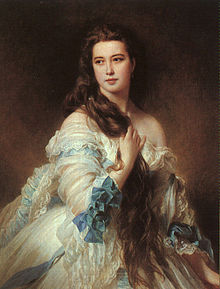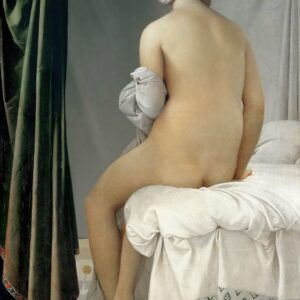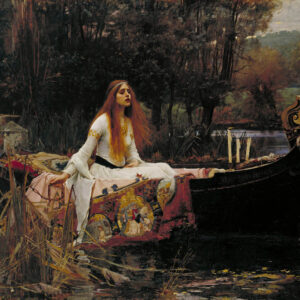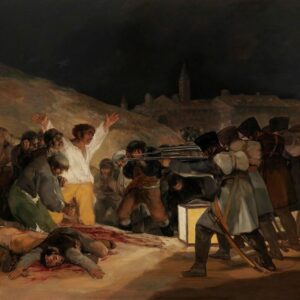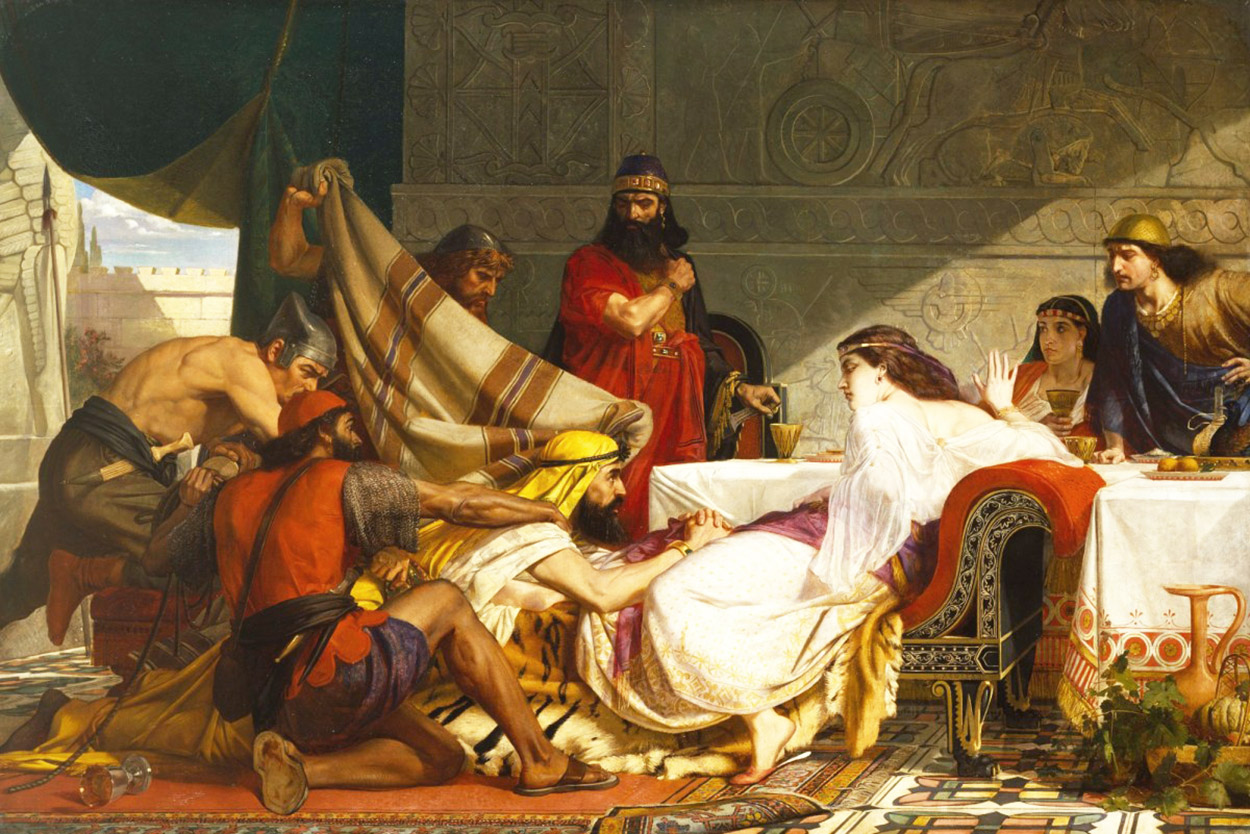Franz Xaver Winterhalter (20 April 1805 – 8 July 1873) was a German painter and lithographer, known for his flattering portraits of royalty and upper-class society in the mid-19th century. His name has become associated with fashionable court portraiture. Among his best known works are Empress Eugénie Surrounded by her Ladies in Waiting (1855) and the portraits he made of Empress Elisabeth of Austria (1865).
In Paris, Winterhalter quickly became fashionable. He was appointed court painter of Louis-Philippe, the king of the French, who commissioned him to paint individual portraits of his large family. Winterhalter would execute more than thirty commissions for him.
This success earned the painter the reputation of a specialist in dynastic and aristocratic portraiture, skilled in combining likeness with flattery and enlivening official pomp with modern fashion.
However, Winterhalter’s reputation in artistic circles suffered. The critics, who had praised his debut in the salon of 1836, dismissed him as a painter who could not be taken seriously. This attitude persisted throughout Winterhalter’s career, condemning his work to a category of his own in the hierarchy of painting. Winterhalter himself regarded his first royal commissions as a temporary intermission before returning to subject painting and the field of academic respectability, but he was a victim of his own success, and for the rest of his life he worked almost exclusively as a portrait painter. His success in this field made him rich. Winterhalter became an international celebrity enjoying Royal patronage.
Katarzyna Potocka in oriental costume (1854), National Museum, Warsaw. Countess Potocka sat for this portrait in Paris, where she went after returning from a trip to the Holy Land. Róża Krasińska, who with her mother went to Paris, wrote that she was “a few times in the Winterhalter’s studio, while the mother posed for her portraits”.[8]
Among his many regal sitters was also Queen Victoria. Winterhalter first visited England in 1842, and returned several times to paint Victoria, Prince Albert and their growing family, painting at least 120 works for them, a large number of which remain in the Royal Collection, on display to the public at Buckingham Palace and other royal residences. On display at Osborne House is Florinda, given by Victoria as a birthday present for Albert in 1852.[9] Winterhalter also painted a few portraits of the aristocracy in England, mostly members of court circles. The fall of Louis-Philippe in 1848 did not affect the painter’s reputation. Winterhalter went to Switzerland and worked in Belgium and England.
The Empress Eugénie Surrounded by her Ladies in Waiting (1855), Château de Compiègne. Taking its inspiration from 18th-century bucolic scenes, this monumental composition sets the empress and her entourage against the backdrop of a shady clearing in a forest. However, the composition is very artificial and formal. The empress, slightly to the left of center, is encircled by and dominates the group.
Persistence saw Winterhalter survive from the fall of one dynasty to the rise of another. Paris remained his home until a couple of years before his death. In the same year, his marriage proposal was rejected, and Winterhalter remained a bachelor committed to his work.
After the accession of Napoleon III, his popularity grew. From then on, under the Second Empire, Winterhalter became the chief portraitist of the imperial family and court of France. The beautiful French Empress Eugénie became a favorite sitter, and she treated him generously. In 1855 Winterhalter painted his masterpiece: The Empress Eugénie Surrounded by her Ladies in Waiting. He set the French Empress in a pastoral setting gathering flowers in a harmonious circle with her ladies in waiting. The painting was acclaimed and exhibited in the universal exposition in 1855. It remains Winterhalter’s most famous work. The composition shows a marked similarity to Florinda and this gave rise to scandalous gossip that the Empress and her ladies had posed déshabillé for the earlier painting.[9]
In 1852, he went to Spain to paint Queen Isabella II with her daughter. Russian aristocratic visitors to Paris also liked to have their portraits executed by the famous master. As the “Painter of Princes”, Winterhalter was thereafter in constant demand by the courts of Britain (from 1841), Spain, Belgium, Russia, Mexico, the German states, and France. During the 1850s and 1860s, Winterhalter painted a number of important portraits of Polish and Russian aristocrats. In 1857, he painted the portrait of Tsarina Maria Alexandrovna.
During the Second Mexican Empire in the 1860s, headed by Maximilian I of Mexico, Winterhalter was commissioned to paint portraits of the Imperial couple. The Empress consort of Mexico, Charlotte of Belgium was the daughter of Louise-Marie of France, Queen of the Belgians, whom Winterhalter painted at the beginning of his career in France. Some of Winterhalter’s paintings of the Mexican monarchs still remain in their Mexico City palace, Chapultepec Castle, now the National Museum of History.
Last years
Barbe Dmitrievna Mergassov Madame Rimsky-Korsakov (1864), oil on canvas, 117 × 90 cm, Musée d’Orsay, Paris.
To deal with those pressing for portrait commissions, many of whom were calling for multiple replicas, Winterhalter made extensive use of assistants. No portrait painter had ever enjoyed such an extraordinary royal patronage as Winterhalter; only Rubens and Van Dyck worked as he did in an international network.
Winterhalter sought respite from the pressures of his work with holidays abroad in Italy, Switzerland, and above all Germany. Despite the many years, he lived in France, he remained deeply attached to his native country. For all his success and popularity, Winterhalter continued to live simply and abstemiously. In 1859 he bought a villa in Baden-Baden, his favorite vacation spot.
In 1864 Winterhalter made his last visit to England. In the autumn of that year he traveled to Vienna to execute the portraits of Emperor Franz Joseph and Empress Elisabeth that remain among his most well-known works. As he grew older, Winterhalter’s links with France weakened while his interest in Germany grew. He was taking a cure in Switzerland at the outbreak of the Franco-Prussian War, the war that ended the Second French Empire. After the war, the painter did not return to France, going instead to Baden. He was officially still accredited at the court of Baden and he settled in Karlsruhe. In the last two years of his life Winterhalter painted very little. During a visit to Frankfurt am Main in the summer of 1873 he contracted typhus and died on 8 July. He was 68 years old.





